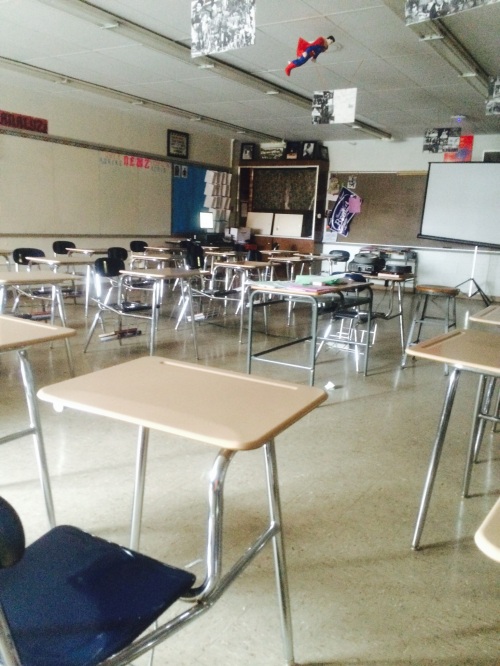Teaching U.S. History in a Failing School
I observed this teacher teaching three history classes a few months ago in a persistently low-performing high school on the cusp of being “restructured.” All names are fictitious.
Standing in the hallway outside of his classroom—a school policy as students move from one class to another–Mark Allison sports a gray-flecked goatee, mustache, and a ponytail of braided dreadlocks. He is wearing a lavender tie on a light, patterned purple shirt with dark-gray cargo pants. A man in his mid-50s he is friendly with students as they pass by calling many by name or “sister” and “brother.” Most of the students say “hi” back, wave, bump fists or shake hands.
Allison teaches African American history and U.S. government. A veteran teacher, he has taught in the District 36 years of which 28 have been at Greenwich High School.
As the tardy chimes sound for the 40 minute period to begin, Allison closes the door and enters a bright, large classroom. On the wall behind the teacher’s desk in one corner of the room (a laptop, the only computer device in the room, sits on Allison’s desk) is a large bulletin board filled with photos of students in his classes. On the opposite wall is a glass-enclosed case displaying famous photos of individuals and events of the Civil Rights movement in the 1960s. Student desks are arranged in a horseshoe with Allison sitting at a student desk in the center of the horseshoe with a slide carousel projector ready for the day’s lesson.
There are three students in the class. Within 10 minutes there are four more. Five minutes before the end of the period, another student enters.
The lesson I observed was part of the unit he teaches on the Civil Rights movement. He begins with the three students by passing out four cards to each one with questions and answers on events during the 1950s and 1960s.
In a game he invented, one student asks a question and another student has to figure out which of the answers he or she has on the four cards is the correct one. As a tardy student entered, Allison paused and said: “are you ready to learn, brother?” He then gave the latecomer the four cards and explained the game quickly. The students were immediately involved and the group expanded to six as latecomers arrived. All six used the Q & A on the cards in their hands as they traded questions and answers (according to Allison’s records, 20 students are enrolled in the course).
Allison sits close to the students listening and, from time to time, coaching those who were having difficulty in either providing an answer or matching the right one to the question asked. For example, one of the questions on the card asks about affirmative action and students were stumped. Allison then gives an Teaching U.S. History in a Failing School | Larry Cuban on School Reform and Classroom Practice:
Preparing Teachers for Urban Schools
“Please to God, if you are going to send … [new teachers] into urban schools, prepare them a bit better than I was prepared.” (quoted in Bethany Rogers, pp. 353-354) If I asked you to guess when this novice teacher said the above words, a good guess might be last week, last month, or last year. Actually, it came from a new teacher who had graduated from a university-based teacher education program
SEP 21
Math Teaching–Cartoons
For the monthly feature of cartoons, I have found that the cartoonist’s pen spared no ink on popular attitudes toward math and how it is taught in schools. Enjoy!

